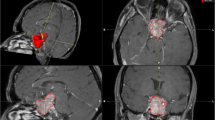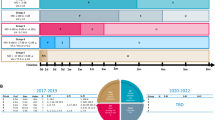Abstract
Objective
Quantitative data on visual outcomes after trans-sphenoidal surgery is lacking in the literature. This study aims to address this by quantitatively assessing visual field outcomes after endoscopic trans-sphenoidal pituitary adenectomy using the capabilities of modern semi-automated kinetic perimetry.
Methods
Visual field area (deg2) calculated on perimetry performed before and after surgery was statistically analysed. Functional improvement was assessed against UK driving standards.
Results
Sixty-four patients (128 eyes) were analysed (May 2016–Nov 2019). I4e and I3e isopter area significantly increased after surgery (p < 0.0001). Of eyes with pre-operative deficits: 80.7% improved and 7.9% worsened; the median amount of improvement was 60% (IQR 6–246%). Median increase in I4e isopter was 2213deg2 (IQR 595–4271deg2) and in I3e isopter 1034 deg2 (IQR 180–2001 deg2). Thirteen out of fifteen (87%) patients with III4e data regained driving eligibility after surgery. Age and extent of resection (EOR) did not correlate with visual improvement. Better pre-operative visual field area correlated with a better post-operative area (p < 0.0001). However, the rate of improvement in the visual field area increased with poorer pre-operative vision (p < 0.0001).
Conclusions
A median visual field improvement of 60% may be expected in over 80% of patients. Functionally, a significant proportion of patients can expect to regain driving eligibility. EOR did not impact on visual recovery. When the primary goal of surgery is alleviating visual impairment, optic apparatus decompression without the aim for gross total resection appears a valid strategy. Patients with the worst pre-operative visual field often experience the greatest improvement, and therefore, poor pre-operative vision alone should not preclude surgical intervention.





Similar content being viewed by others
References
Abouaf L, Vighetto A, Lebas M (2015) Neuro-ophthalmologic exploration in non-functioning pituitary adenoma. Ann Endocrinol (Paris) 76(3):210–9. https://doi.org/10.1016/j.ando.2015.04.006
Akin S, Isikay I, Soylemezoglu F, Yucel T, Gurlek A, Berker M (2016) Reasons and results of endoscopic surgery for prolactinomas: 142 surgical cases. Acta Neurochir (Wien) 158(5):933–42. https://doi.org/10.1007/s00701-016-2762-z
Anik I, Anik Y, Koc K et al (2011) Evaluation of early visual recovery in pituitary macroadenomas after endoscopic endonasal transphenoidal surgery: quantitative assessment with diffusion tensor imaging (DTI). Acta Neurochir (Wien) 153(4):831–42. https://doi.org/10.1007/s00701-011-0942-4
Anik I, Anik Y, Cabuk B et al (2018) Visual outcome of an endoscopic endonasal transsphenoidal approach in pituitary macroadenomas: quantitative assessment with diffusion tensor imaging early and long-term results. World Neurosurg 112:e691–e701. https://doi.org/10.1016/j.wneu.2018.01.134
Barzaghi LR, Medone M, Losa M, Bianchi S, Giovanelli M, Mortini P (2012) Prognostic factors of visual field improvement after trans-sphenoidal approach for pituitary macroadenomas: review of the literature and analysis by quantitative method. Neurosurg Rev 35(3):369–378
Birch DG, Bernstein PS, Iannacone A et al (2018) Effect of oral valproic acid vs placebo for vision loss in patients with autosomal dominant Retinitis pigmentosa: a randomized phase 2 multicenter placebo-controlled clinical trial. JAMA Ophthalmol 136(8):849–856
Blaauw G, Braakman R, Cuhadar M, et al (1986) Influence of transsphenoidal hypophysectomy on visual deficit due to a pituitary tumour. Acta Neurochir (Wien) 83(3–4):79–82.: https://doi.org/10.1007/BF01402382
Chabot JD, Chakraborty S, Imbarrato G, Dehdashti AR (2015) Evaluation of outcomes after endoscopic endonasal surgery for large and giant pituitary macroadenoma: a retrospective review of 39 consecutive patients. World Neurosurg 84(4):978–88. https://doi.org/10.1016/j.wneu.2015.06.007
Christoforidis JB (2011) Volume of visual field assessed with kinetic perimetry and its application to static perimetry. Clin Ophthalmol 5(535):41. https://doi.org/10.2147/OPTH.S18815
Ciric I, Mikhael M, Stafford T, Lawson L, Garces R (1983) Transsphenoidal microsurgery of pituitary macroadenomas with long-term follow-up results. J Neurosurg 59(3):395–401. https://doi.org/10.3171/jns.1983.59.3.0395
Cohen AR, Cooper PR, Kupersmith MJ, Flamm ES, Ransohoff J (1985) Visual recovery after transsphenoidal removal of pituitary adenomas. Neurosurg 17(3):446–52. https://doi.org/10.1227/00006123-198509000-00008
Dagnelie G (1990) Conversion of planimetric visual-field data into solid angles and retinal areas. Clin Vision Sci 5:95Y100
Dallapiazza RF, Grober Y, Starke RM, Laws ER Jr, Jane JA Jr. (2015) Long-term results of endonasal endoscopic transsphenoidal resection of nonfunctioning pituitary macroadenomas. Neurosurg 76(1):42–52; discussion 52–3. https://doi.org/10.1227/NEU.0000000000000563
Danesh-Meyer HV, Wong A, Papchenko T, Matheos K, Stylli S, Nichols A, Frampton C, Daniell M, Savino PJ, Kaye AH (2015) Optical coherence tomography predicts visual outcome for pituitary tumors. J Clin Neurosci 22(7):1098–104. https://doi.org/10.1016/j.jocn.2015.02.001
Danesh-Meyer HV, Savino PJ (2009) The role of retinal nerve fiber layer in predicting recovery of vision following surgery for pituitary adenomas. Am J Ophthalmol 147(6):1103–4; author reply 1104. https://doi.org/10.1016/j.ajo.2009.02.016
Dehdashti AR, Ganna A, Karabatsou K, Gentili F (2008) Pure endoscopic endonasal approach for pituitary adenomas: early surgical results in 200 patients and comparison with previous microsurgical series. Neurosurg 62(5):1006–15; discussion 1015–7. https://doi.org/10.1227/01.neu.0000325862.83961.12
D’Haens J, Van Rompaey K, Stadnik T, Haentjens P, Poppe K, Velkeniers B (2009) Fully endoscopic transsphenoidal surgery for functioning pituitary adenomas: a retrospective comparison with traditional transsphenoidal microsurgery in the same institution. Surg Neurol 72(4):336–40. https://doi.org/10.1016/j.surneu.2009.04.012
Fahlbusch R, Schott W (2002) Pterional surgery of meningiomas of the tuberculum sellae and planum sphenoidale: surgical results with special consideration of ophthalmological and endocrinological outcomes. J Neurosurg 96(2):235-43.: https://doi.org/10.3171/jns.2002.96.2.0235
Findlay G, McFadzean RM, Teasdale G (1983) Recovery of vision following treatment of pituitary tumours: application of a new system of visual assessment. Trans Ophthalmol Soc UK 103(Pt 2):212–216
Fredes F, Undurraga G, Rojas P et al (2017) Visual outcomes after endoscopic pituitary surgery in patients presenting with preoperative visual deficits. J Neurol Surg B Skull Base 78(6):461–465. https://doi.org/10.1055/s-0037-1604169
Gnanalingham KK, Bhattacharjee S, Pennington R, Ng J, Mendoza N (2005) The time course of visual field recovery following transphenoidal surgery for pituitary adenomas: predictive factors for a good outcome. J Neurol Neurosurg Psychiatry 76(3):415–9. https://doi.org/10.1136/jnnp.2004.035576
Gov.uk.(2021) Guidance: Visual disorders: assessing fitness to drive. Accessed 1 June 2021. https://www.gov.uk/guidance/visual-disorders-assessing-fitness-to-drive
Grobbel J, Dietzsch J, Johnson CA et al (2016) Normal values for the full visual field, corrected for age- and reaction time, using semiautomated kinetic testing on the Octopus 900 perimeter. Transl Vis Sci Technol 5(2):5
Ho RW, Huang HM, Ho JT (2015) The influence of pituitary adenoma size on vision and visual outcomes after trans-sphenoidal adenectomy: a report of 78 cases. J Korean Neurosurg Soc 57(1):23–31. https://doi.org/10.3340/jkns.2015.57.1.23
Ikeda H, Yoshimoto T (1995) Visual disturbances in patients with pituitary adenoma. Acta Neurol Scand 92(2):157–60. https://doi.org/10.1111/j.1600-0404.1995.tb01031.x
Jaeger W, Thomann H (1982) Deutsche Ophthalmologische Ge- sellschaft. Empfehlungen zur Beurteilung der Minderung der Erwebsfähigkeit durch Schäden des Sehvermögens. Klin Mbl Augenheilk 180:242–245
Juraschka K, Khan OH, Godoy BL et al (2014) Endoscopic endonasal transsphenoidal approach to large and giant pituitary adenomas: institutional experience and predictors of extent of resection. J Neurosurg 121(1):75–83
Karppinen A, Kivipelto L, Vehkavaara S et al (2015) Transition from microscopic to endoscopic transsphenoidal surgery for nonfunctional pituitary adenomas. World Neurosurg 84(1):48–57. https://doi.org/10.1016/j.wneu.2015.02.024
Kerrison JB, Lynn MJ, Baer CA et al (2000) Stages of improvement in visual fields after pituitary tumor resection. Am J Ophthalmol 130:813–820
Lilja Y, Gustafsson O, Ljungberg M et al (2016) Visual pathway impairment by pituitary adenomas: quantitative diagnostics by diffusion tensor imaging. J Neurosurg 127(3):569–579. https://doi.org/10.3171/2016.8.JNS161290
Makarenko S, Ye V, Gooderham PA, Akagami R (2018) A novel scale for describing visual outcomes in patients following resection of lesions affecting the optic apparatus: the Unified Visual Function Scale. J Neurosurg 129(6):1438–1445. https://doi.org/10.3171/2017.6.JNS17707
Mangione CM, Lee PP, Gutierrez PR, Spritzer K, Berry S, Hays RD (2001) National Eye Institute Visual Function Questionnaire Field Test Investigators. Development of the 25-item National Eye Institute Visual Function Questionnaire. Arch Ophthalmol 119(7):1050–8. https://doi.org/10.1001/archopht.119.7.1050
Mangione CM, Phillips RS, Seddon JM et al (1992) Development of the ‘activities of daily vision scale’. A measure of visual functional status. Med Care 30:1111–1126
Marenco HA, Zymberg ST, Santos Rde P, Ramalho CO (2015) Surgical treatment of non-functioning pituitary macroadenomas by the endoscopic endonasal approach in the elderly. Arq Neuropsiquiatr 73(9):764–9. https://doi.org/10.1590/0004-282X20150112
Molitch ME (2017) Diagnosis and treatment of pituitary adenomas: a review. JAMA 317(5):516–524. https://doi.org/10.1001/jama.2016.19699
Monteiro ML, Zambon BK, Cunha LP (2010) Predictive factors for the development of visual loss in patients with pituitary macroadenomas and for visual recovery after optic pathway decompression. Can J Ophthalmol 45(4):404–8. https://doi.org/10.3129/i09-276
Muskens IS, ZamanipoorNajafabadi AH, Briceno V et al (2017) Visual outcomes after endoscopic endonasal pituitary adenoma resection: a systematic review and meta-analysis. Pituitary 20(5):539–552. https://doi.org/10.1007/s11102-017-0815-9
Nakao N, Itakura T (2011) Surgical outcome of the endoscopic endonasal approach for non-functioning giant pituitary adenoma. J Clin Neurosci 18(1):71-5.: https://doi.org/10.1016/j.jocn.2010.04.049
Okamoto Y, Okamoto F, Hiraoka T, Yamada S, Oshika T (2008) Vision-related quality of life in patients with pituitary adenoma. Am J Ophthalmol 146(2):318–322. https://doi.org/10.1016/j.ajo.2008.04.018
Paluzzi A, Fernandez-Miranda JC, Tonya Stefko S, Challinor S, Snyderman CH, Gardner PA (2014) Endoscopic endonasal approach for pituitary adenomas: a series of 555 patients. Pituitary 17(4):307–19. https://doi.org/10.1007/s11102-013-0502-4
Powell M (1995) Recovery of vision following transsphenoidal surgery for pituitary adenomas. Br J Neurosurg 9(3):367–73. https://doi.org/10.1080/02688699550041377
Rowe FJ, Noonan C, Manuel M (2013) Comparison of octopus semi-automated kinetic perimetry and humphrey peripheral static perimetry in neuro-ophthalmic cases. ISRN Ophthalmol. 2013;753202.:https://doi.org/10.1155/2013/753202
Rowe FJ, Cheyne CP, García-Fiñana M et al (2015) Detection of visual field loss in pituitary disease: peripheral kinetic versus central static. Neuroophthalmology 39(3):116–124. https://doi.org/10.3109/01658107.2014.990985
Rowe FJ, Czanner G, Somerville T, Sood I, Sood D (2020) Octopus 900 Automated kinetic perimetry versus standard automated static perimetry in glaucoma practice. Curr Eye Res 46(1):83–95. https://doi.org/10.1080/02713683.2020.1786133
Wang MTM, King J, Symons RCA, et al (2021) Temporal patterns of visual recovery following pituitary tumor resection: a prospective cohort study. J Clin Neurosci 86:252-259.: https://doi.org/10.1016/j.jocn.2021.01.007
Acknowledgements
Department of Ophthalmology, Leeds Teaching Hospitals.
Author information
Authors and Affiliations
Contributions
All authors contributed to the study conception and design. Material preparation, data collection and analysis were performed by Dhruv Parikh. The first draft of the manuscript was written by Dhruv Parikh and all authors commented on previous versions of the manuscript. All authors read and approved the final manuscript.
Corresponding author
Ethics declarations
Conflict of interest
The authors declare no competing interests.
Additional information
Publisher's note
Springer Nature remains neutral with regard to jurisdictional claims in published maps and institutional affiliations.
This article is part of the Topical Collection on Pituitaries.
Rights and permissions
About this article
Cite this article
Parikh, D., Robins, J.M.W., Garretty, T. et al. Quantitative and functional visual field outcomes after endoscopic trans-sphenoidal pituitary adenectomy. Acta Neurochir 164, 1605–1614 (2022). https://doi.org/10.1007/s00701-022-05198-7
Received:
Accepted:
Published:
Issue Date:
DOI: https://doi.org/10.1007/s00701-022-05198-7




